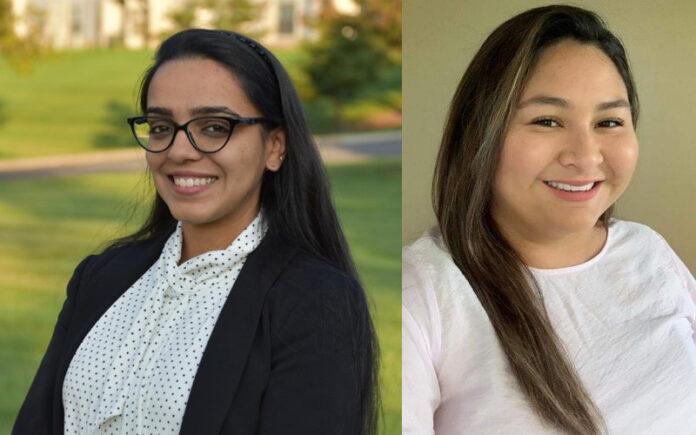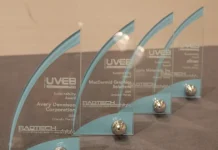RadTech’s Young Professionals Network highlights the work of Prutha Joshi, a senior chemist at 7D Innovators’ Research Center in Dexter, Michigan; and Jennifer Chavez, an R&D materials engineer centered on additive manufacturing at Align Technology in San Jose, California.
Joshi is a senior chemist at 7D Innovators’ Research Center in Dexter, Michigan. Her work is formulation, optimization and evaluation of UV/EB resins, with a focus on coatings, graphic arts and 3D printing applications. She received her Bachelor’s in Chemical Technology from the Institute of Chemical Technology, India, and an M.S. and a Ph.D. in Polymer Engineering from Auburn University, Auburn, Alabama.
“First and foremost, the challenge I felt was in turning my academic research perspective (while pursuing a Ph.D.) into industrial research.” – Prutha Joshi
Chavez is an R&D materials engineer centered on additive manufacturing at Align Technology in San Jose, California, focusing on photopolymer formulations and research processes for directly printed orthodontic devices. She received her B.S. in Chemistry from Texas A&M University, College Station, Texas. Outside of work, she enjoys cooking new food recipes and traveling, and she recently learned to road cycle.
“As a young professional in the photopolymer AM industry, one of the challenges I faced was the multidisciplinary nature of my work.” – Jennifer Chavez
RTYP: Tell us about your background and what you are working on now.
PJ: As a senior chemist at 7D Innovators, I am currently working on SLA and DLP 3D printing, design and optimization with different printers for a variety of applications – automobile, dental devices and coatings. I explore new UV chemistries and evaluate [their] performance in commercial UV-curable formulations.
JC: While I was in school, I interned at Sherwin-Williams, working on coatings for the automotive sector. After graduating, I worked at Formlabs in developing photopolymers for SLA 3D printing. Currently, I am working on photopolymer development for additive manufacturing (AM) of orthodontic (devices). As I develop a new formulation, choosing an appropriate AM technology and downstream process also is investigated. My role consists of developing and characterizing formulations as well as investigating respective AM technology that can be used to manufacture end-use dental devices.
RTYP: When did you first learn about UV/EB as an industry and technology?
PJ: I took an Additive Manufacturing course as a part of my doctoral coursework. I applied that knowledge of photopolymerization chemistry during the experimental work as a part of my thesis. 3D printing of biopolymer hydrogels for tissue engineering applications was a major part of my study.
JC: My first introduction to the subject was during my three-month internship at Formlabs in Boston, Massachusetts. While there, my work focused on photopolymer development for the company’s Form2 printer. Much of my work was focused on in-printer curing parameters and their influence on overall mechanical properties.
RTYP: How different is it to work in the medical device field?
PJ: In the medical field, you really must look at more than just the physical properties of the materials being used in medical applications. The cytotoxicity and FDA-approved materials/polymers are the most surprising differences here as the end products may come in contact with any part of the human body and safety is essential.
JC: The medical device industry is a highly regulated industry. We have very high bars on the requirements of safety and toxicology (of the materials). These requirements make it difficult for (the materials development in) the medical device industry to move as fast as the other industries, but it is important that we adhere to all the regulations and requirements.
RTYP: What challenges have you run into as a young professional?
PJ: First and foremost, the challenge I felt was in turning my academic research perspective (while pursuing a Ph.D.) into industrial research. Also, as a young professional, communication and connections are important aspects to tackle. The ability to make your thinking (idea) visible to others in-person and virtually with the digital footprint is a challenge. And sometimes networking can be overwhelming, especially if you are introverted (like me), but “your network is your net worth.”
JC: As a young professional in the photopolymer AM industry, one of the challenges I faced was the multidisciplinary nature of my work. Although educated as a chemist, my work draws on a variety of technical disciplines that make the learning curve to AM photopolymers steep. This has helped me to step out of my comfort zone and learn new technical skills to tackle an ever-changing AM landscape.
RTYP: How could we encourage more young professionals to get involved in UV and EB technology?
PJ: Conferences, especially RadTech conferences, would be (a good place) where young professionals can get exposure to a lot of companies and meet other YPs.
JC: Targeting schools and universities that are well known for polymers, organic chemistry and engineering to see if there is any interest among young professionals to have an opportunity to see what’s even out there would be one way.
RTYP: Could you tell us about someone who has influenced your work?
PJ: The idea of photopolymerization chemistry was introduced by my Ph.D. research advisor Dr. Maria L. Auad (Auburn University), which really played an important role in (shaping) the vision of my academic research work. However, the industrial UV/EB research is completely different and comes with new challenges. In this, I get motivated by the knowledge and experience of Paul Snowwhite, president of 7D Innovators. There is so much to learn from many others as well who are helping me grow.
JC: Dr. Bill Howell has been a mentor of mine since my undergraduate studies. He always has emphasized the importance of exposure to diverse work experiences. This piece of advice was key in helping shape why I choose AM as a career choice. Recalling Dr. Howell’s advice and always considering an open mind, I have had the opportunity to work in a wide range of industries: automotive coatings, OEM photopolymer development, and now AM photopolymers for the medical device industry.
The RadTech YP Committee aims to help young professionals (YPs) grow in the use and development of UV & EB technology. It is a group dedicated to enhancing interactions between YPs and senior experts within RadTech. YPs are students and professionals early in their careers who utilize UV & EB technology in industry, government or academia. For more information, contact us at yp@radtech.org.






